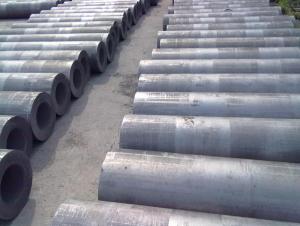When we talk about the design of graphite electrodes, it’s like diving into the heart of an industrial artist’s masterpiece. It’s not just about the technicalities; it’s about the passion, the creativity, and the drive to make something that’s not only functional but also a testament to human ingenuity.
Graphite electrodes are the unsung heroes of many industrial processes, especially in electric arc furnaces (EAFs) where they play a crucial role in melting and refining metals. But, have you ever wondered how these electrodes are designed? What goes into making them the perfect tools for their job? Let’s explore the nitty-gritty of graphite electrode design, with a touch of personality and a sprinkle of passion.
First things first, the raw material itself – graphite. This wonder mineral is chosen for its exceptional properties like high electrical conductivity, thermal conductivity, and resistance to heat. It’s the backbone of our story, the silent strength that holds everything together.
Now, let’s get into the design process. It’s not as simple as sketching a line and calling it a day. It’s a meticulous journey that starts with understanding the purpose of the electrode. Is it for a small furnace or a massive one? The size and shape of the electrode will vary accordingly. It’s like tailoring a suit – you need the perfect fit for the job at hand.
The next step is to consider the electrode’s structure. It’s not just about making it long and sturdy; it must also be resistant to the harsh conditions it will face. Think of it as preparing a warrior for battle – you need to armor them up to withstand the heat, the pressure, and the wear and tear.
And then comes the fun part – the nipple design. Yes, you read that right. The ‘nipple’ is the part of the electrode that connects it to the rest of the system. It’s the link, the handshake between the electrode and the furnace. Designing this part requires precision and a keen eye for detail. It’s like crafting the perfect key to a lock – it has to fit just right to ensure a seamless connection.
But why is the nipple design so important? Well, it’s the point of contact, the place where the electrode meets its destiny. If it’s not designed well, it can lead to inefficiencies, increased downtime, and even safety hazards. It’s the difference between a smooth operation and a chaotic mess.
As we delve deeper into the design, we also need to consider the electrode’s performance. How long will it last? How well will it perform under different conditions? These are the questions that keep engineers up at night, pondering and perfecting their creations.
One of the key factors in electrode performance is the quality of the graphite used. High-quality graphite ensures a longer lifespan and better performance. It’s like choosing the right ingredients for a recipe – you want the best to make the best.
Another aspect to consider is the electrode’s resistance to oxidation. In the high-temperature environment of an EAF, oxidation can be a real threat. The design must incorporate features that protect the electrode from this enemy, ensuring it remains strong and reliable.
And let’s not forget about the electrode’s flexibility. It’s not just about being rigid and unyielding; the electrode needs to have a certain degree of flexibility to adapt to the ever-changing conditions within the furnace. It’s like a dancer – graceful, adaptable, and always ready to move with the rhythm of the process.
Now, as we bring our design to life, we need to think about the manufacturing process. It’s not just about creating a prototype; it’s about producing electrodes that meet the highest standards of quality and performance. This is where the real magic happens – turning a concept into a reality that can withstand the test of time and the rigors of the job.
Finally, we arrive at the testing phase. This is where we put our electrode through its paces, ensuring it can perform under the most demanding conditions. It’s like a final exam for our creation – a chance to prove its worth and demonstrate its capabilities.
In conclusion, the design of graphite electrodes is a complex and fascinating process that requires a deep understanding of materials, performance, and manufacturing techniques. It’s a blend of science, art, and a touch of madness. It’s about pushing the boundaries and striving for perfection, all while keeping safety and efficiency at the forefront of our minds. So, the next time you see a graphite electrode, remember the passion, the creativity, and the hard work that went into making it the indispensable tool it is today.

